Bootstrap Form Button
Introduction
Bootstrap presents a number of form manage styles, layout options, and custom components for creating a wide variety of Bootstrap Form Template.
Forms give the awesome system for gaining some comments directly from the website visitors of our webpages. In the case that it's a simple connection or subscription form with simply just a couple of fields or a sophisticated and very well thought inquiry the Bootstrap 4 framework got all things that's required to do the task and get outstanding responsive appeal.
By default within the Bootstrap framework the form components are styled to span the entire width of its parent element-- this stuff becomes achieved by assigning the .form-control class. The commands and lebels ought to be wrapped inside a parent element along with the .form-group class for effective spacing.
Bootstrap Form Button regulations
Bootstrap's form controls increase with regards to our Rebooted form designs with classes.
Use these classes to opt in their modified displays for a additional steady rendering over accessories and web browsers . The sample form listed here displays basic HTML form features that earn updated designs coming from Bootstrap together with supplementary classes.
Remember, since Bootstrap utilizes the HTML5 doctype, all types of inputs must feature a type attribute.


<form>
<div class="form-group">
<label for="exampleInputEmail1">Email address</label>
<input type="email" class="form-control" id="exampleInputEmail1" aria-describedby="emailHelp" placeholder="Enter email">
<small id="emailHelp" class="form-text text-muted">We'll never share your email with anyone else.</small>
</div>
<div class="form-group">
<label for="exampleInputPassword1">Password</label>
<input type="password" class="form-control" id="exampleInputPassword1" placeholder="Password">
</div>
<div class="form-group">
<label for="exampleSelect1">Example select</label>
<select class="form-control" id="exampleSelect1">
<option>1</option>
<option>2</option>
<option>3</option>
<option>4</option>
<option>5</option>
</select>
</div>
<div class="form-group">
<label for="exampleSelect2">Example multiple select</label>
<select multiple class="form-control" id="exampleSelect2">
<option>1</option>
<option>2</option>
<option>3</option>
<option>4</option>
<option>5</option>
</select>
</div>
<div class="form-group">
<label for="exampleTextarea">Example textarea</label>
<textarea class="form-control" id="exampleTextarea" rows="3"></textarea>
</div>
<div class="form-group">
<label for="exampleInputFile">File input</label>
<input type="file" class="form-control-file" id="exampleInputFile" aria-describedby="fileHelp">
<small id="fileHelp" class="form-text text-muted">This is some placeholder block-level help text for the above input. It's a bit lighter and easily wraps to a new line.</small>
</div>
<fieldset class="form-group">
<legend>Radio buttons</legend>
<div class="form-check">
<label class="form-check-label">
<input type="radio" class="form-check-input" name="optionsRadios" id="optionsRadios1" value="option1" checked>
Option one is this and that—be sure to include why it's great
</label>
</div>
<div class="form-check">
<label class="form-check-label">
<input type="radio" class="form-check-input" name="optionsRadios" id="optionsRadios2" value="option2">
Option two can be something else and selecting it will deselect option one
</label>
</div>
<div class="form-check disabled">
<label class="form-check-label">
<input type="radio" class="form-check-input" name="optionsRadios" id="optionsRadios3" value="option3" disabled>
Option three is disabled
</label>
</div>
</fieldset>
<div class="form-check">
<label class="form-check-label">
<input type="checkbox" class="form-check-input">
Check me out
</label>
</div>
<button type="submit" class="btn btn-primary">Submit</button>
</form>Below is a full catalog of the certain Bootstrap Form Example regulations supported by Bootstrap along with the classes which customise them. Additional documentation is readily available for each and every group.
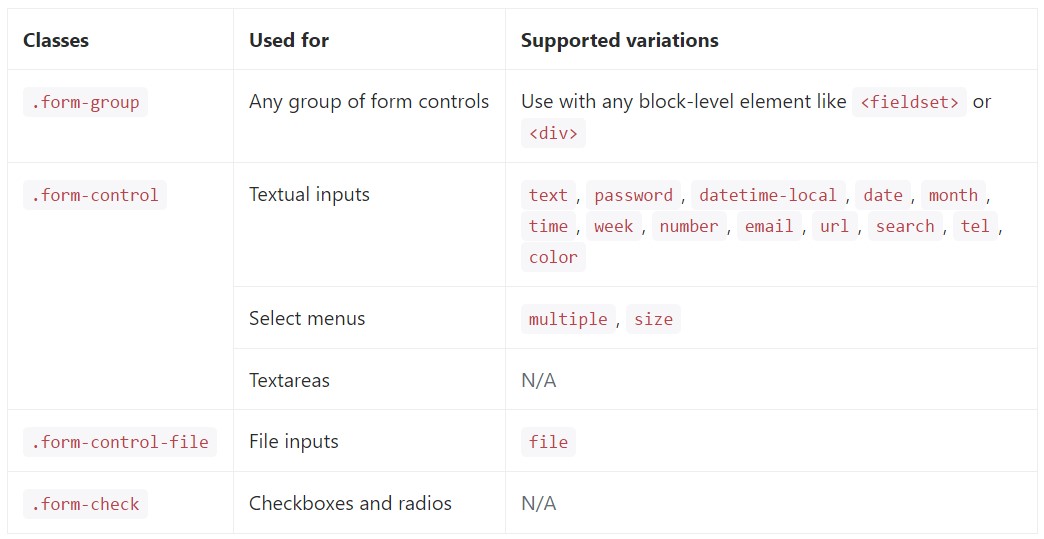
Textual inputs
Right here are the examples of .form-control related to each textual HTML5 <input> type.
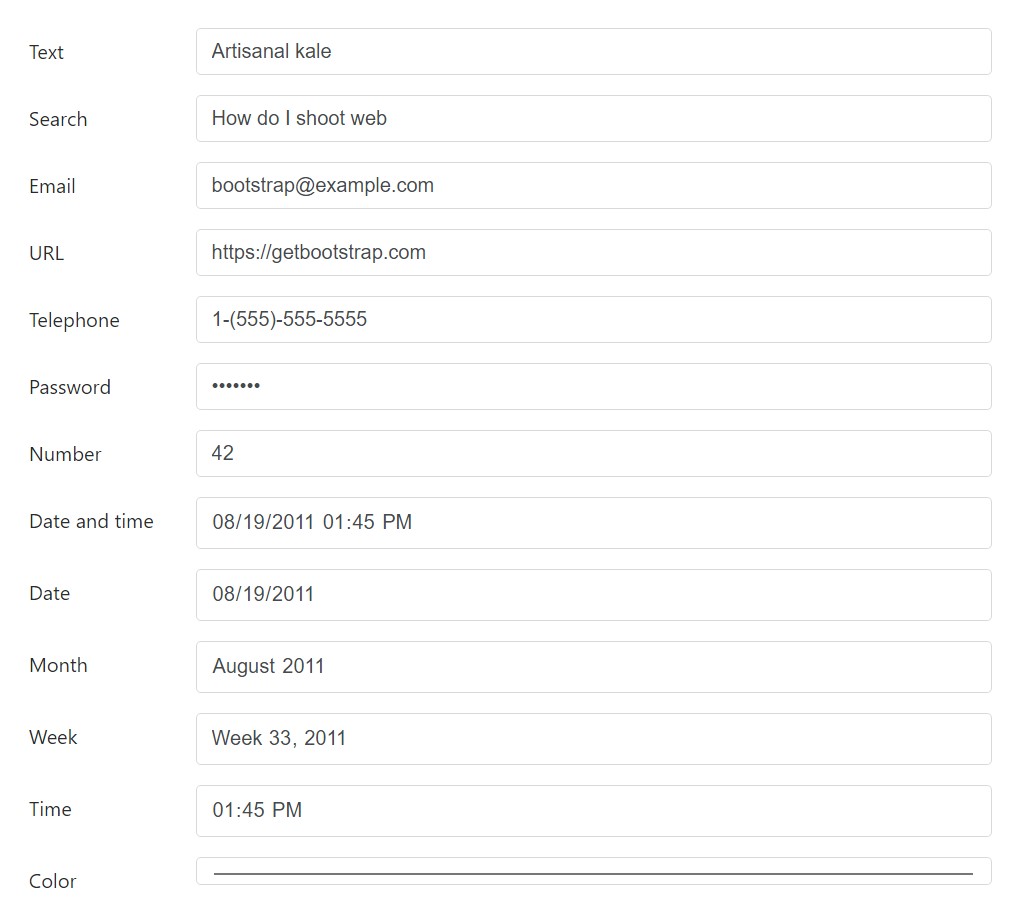
<div class="form-group row">
<label for="example-text-input" class="col-2 col-form-label">Text</label>
<div class="col-10">
<input class="form-control" type="text" value="Artisanal kale" id="example-text-input">
</div>
</div>
<div class="form-group row">
<label for="example-search-input" class="col-2 col-form-label">Search</label>
<div class="col-10">
<input class="form-control" type="search" value="How do I shoot web" id="example-search-input">
</div>
</div>
<div class="form-group row">
<label for="example-email-input" class="col-2 col-form-label">Email</label>
<div class="col-10">
<input class="form-control" type="email" value="[email protected]" id="example-email-input">
</div>
</div>
<div class="form-group row">
<label for="example-url-input" class="col-2 col-form-label">URL</label>
<div class="col-10">
<input class="form-control" type="url" value="https://getbootstrap.com" id="example-url-input">
</div>
</div>
<div class="form-group row">
<label for="example-tel-input" class="col-2 col-form-label">Telephone</label>
<div class="col-10">
<input class="form-control" type="tel" value="1-(555)-555-5555" id="example-tel-input">
</div>
</div>
<div class="form-group row">
<label for="example-password-input" class="col-2 col-form-label">Password</label>
<div class="col-10">
<input class="form-control" type="password" value="hunter2" id="example-password-input">
</div>
</div>
<div class="form-group row">
<label for="example-number-input" class="col-2 col-form-label">Number</label>
<div class="col-10">
<input class="form-control" type="number" value="42" id="example-number-input">
</div>
</div>
<div class="form-group row">
<label for="example-datetime-local-input" class="col-2 col-form-label">Date and time</label>
<div class="col-10">
<input class="form-control" type="datetime-local" value="2011-08-19T13:45:00" id="example-datetime-local-input">
</div>
</div>
<div class="form-group row">
<label for="example-date-input" class="col-2 col-form-label">Date</label>
<div class="col-10">
<input class="form-control" type="date" value="2011-08-19" id="example-date-input">
</div>
</div>
<div class="form-group row">
<label for="example-month-input" class="col-2 col-form-label">Month</label>
<div class="col-10">
<input class="form-control" type="month" value="2011-08" id="example-month-input">
</div>
</div>
<div class="form-group row">
<label for="example-week-input" class="col-2 col-form-label">Week</label>
<div class="col-10">
<input class="form-control" type="week" value="2011-W33" id="example-week-input">
</div>
</div>
<div class="form-group row">
<label for="example-time-input" class="col-2 col-form-label">Time</label>
<div class="col-10">
<input class="form-control" type="time" value="13:45:00" id="example-time-input">
</div>
</div>
<div class="form-group row">
<label for="example-color-input" class="col-2 col-form-label">Color</label>
<div class="col-10">
<input class="form-control" type="color" value="#563d7c" id="example-color-input">
</div>
</div>Form arrangements
Due to the fact that Bootstrap applies display: block and width :100% to most of our form controls, forms are going to by default stack vertically. More classes may be applied to vary this particular layout on a per-form basis.
Form categories
The .form-group class is the fastest procedure to add amazing building to forms. Its main target is to deliver margin-bottom about a label and manage pairing. As a bonus, since it is actually a class you can utilize it utilizing <fieldset>-s, <div>-s, or pretty much most other feature.

<form>
<div class="form-group">
<label for="formGroupExampleInput">Example label</label>
<input type="text" class="form-control" id="formGroupExampleInput" placeholder="Example input">
</div>
<div class="form-group">
<label for="formGroupExampleInput2">Another label</label>
<input type="text" class="form-control" id="formGroupExampleInput2" placeholder="Another input">
</div>
</form>Inline forms
Use the .form-inline class to feature a variety of labels, form managements , plus buttons upon a solitary horizontal row. Form controls within inline forms are different slightly from their default states.
- Controls are display: flex, collapsing all HTML white territory and making it possible for you to supply alignment regulation having spacing plus flexbox utilities.
- Controls and input groups are given width: auto to defeat the Bootstrap default width: 100%.
- Controls only appear inline inside viewports that are at very least 576px big to consider slim viewports on mobile devices.
You may likely ought to personally deal with the size and placement of specific form controls with spacing utilities ( just as indicated below) And lastly, be sure to always include a <label> with every form control, even if you require to hide it from non-screenreader site visitors with a code.

<form class="form-inline">
<label class="sr-only" for="inlineFormInput">Name</label>
<input type="text" class="form-control mb-2 mr-sm-2 mb-sm-0" id="inlineFormInput" placeholder="Jane Doe">
<label class="sr-only" for="inlineFormInputGroup">Username</label>
<div class="input-group mb-2 mr-sm-2 mb-sm-0">
<div class="input-group-addon">@</div>
<input type="text" class="form-control" id="inlineFormInputGroup" placeholder="Username">
</div>
<div class="form-check mb-2 mr-sm-2 mb-sm-0">
<label class="form-check-label">
<input class="form-check-input" type="checkbox"> Remember me
</label>
</div>
<button type="submit" class="btn btn-primary">Submit</button>
</form>Custom form controls as well as picks are as well assisted.

<form class="form-inline">
<label class="mr-sm-2" for="inlineFormCustomSelect">Preference</label>
<select class="custom-select mb-2 mr-sm-2 mb-sm-0" id="inlineFormCustomSelect">
<option selected>Choose...</option>
<option value="1">One</option>
<option value="2">Two</option>
<option value="3">Three</option>
</select>
<label class="custom-control custom-checkbox mb-2 mr-sm-2 mb-sm-0">
<input type="checkbox" class="custom-control-input">
<span class="custom-control-indicator"></span>
<span class="custom-control-description">Remember my preference</span>
</label>
<button type="submit" class="btn btn-primary">Submit</button>
</form>Alternatives to covered up labels
Assistive modern technologies for instance, screen readers will certainly have issue along with your forms in the event that you do not include a label for each input. For these inline forms, you have the ability to conceal the labels utilizing the .sr-only class. There are actually additional different options of presenting a label for assistive technological innovations, for example, the aria-label, aria-labelledby or title attribute. If not one of these are present, assistive technologies may likely resort to employing the placeholder attribute, in the case that available, but bear in mind that application of placeholder as a substitution for other labelling techniques is definitely not suggested.
Utilizing the Grid
For additionally structured form layouts that are equally responsive, you can surely employ Bootstrap's predefined grid classes alternatively mixins to create horizontal forms. Provide the .row class to form groups and utilize the .col-*-* classes in order to define the width of your labels and controls.
Be sure to add .col-form-label to your <label>-s as well so they’re vertically centered with their associated form controls. For <legend> elements, you can use .col-form-legend to make them appear similar to regular <label> elements.
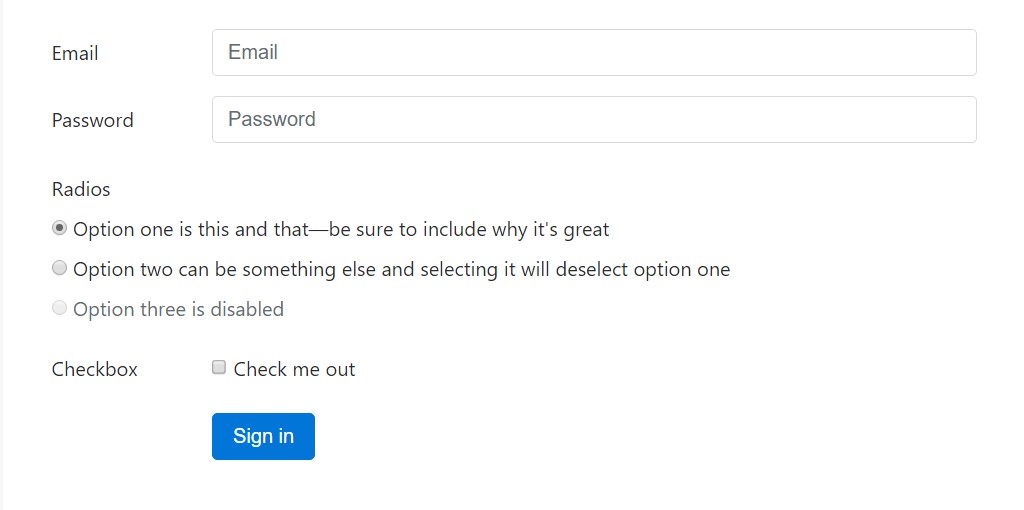
<div class="container">
<form>
<div class="form-group row">
<label for="inputEmail3" class="col-sm-2 col-form-label">Email</label>
<div class="col-sm-10">
<input type="email" class="form-control" id="inputEmail3" placeholder="Email">
</div>
</div>
<div class="form-group row">
<label for="inputPassword3" class="col-sm-2 col-form-label">Password</label>
<div class="col-sm-10">
<input type="password" class="form-control" id="inputPassword3" placeholder="Password">
</div>
</div>
<fieldset class="form-group row">
<legend class="col-form-legend col-sm-2">Radios</legend>
<div class="col-sm-10">
<div class="form-check">
<label class="form-check-label">
<input class="form-check-input" type="radio" name="gridRadios" id="gridRadios1" value="option1" checked>
Option one is this and that—be sure to include why it's great
</label>
</div>
<div class="form-check">
<label class="form-check-label">
<input class="form-check-input" type="radio" name="gridRadios" id="gridRadios2" value="option2">
Option two can be something else and selecting it will deselect option one
</label>
</div>
<div class="form-check disabled">
<label class="form-check-label">
<input class="form-check-input" type="radio" name="gridRadios" id="gridRadios3" value="option3" disabled>
Option three is disabled
</label>
</div>
</div>
</fieldset>
<div class="form-group row">
<label class="col-sm-2">Checkbox</label>
<div class="col-sm-10">
<div class="form-check">
<label class="form-check-label">
<input class="form-check-input" type="checkbox"> Check me out
</label>
</div>
</div>
</div>
<div class="form-group row">
<div class="offset-sm-2 col-sm-10">
<button type="submit" class="btn btn-primary">Sign in</button>
</div>
</div>
</form>
</div>Grid-based form configurations additionally provide large size and small-sized inputs.

<div class="container">
<form>
<div class="form-group row">
<label for="lgFormGroupInput" class="col-sm-2 col-form-label col-form-label-lg">Email</label>
<div class="col-sm-10">
<input type="email" class="form-control form-control-lg" id="lgFormGroupInput" placeholder="[email protected]">
</div>
</div>
<div class="form-group row">
<label for="smFormGroupInput" class="col-sm-2 col-form-label col-form-label-sm">Email</label>
<div class="col-sm-10">
<input type="email" class="form-control form-control-sm" id="smFormGroupInput" placeholder="[email protected]">
</div>
</div>
</form>
</div>Checkboxes and radios
Default radios and checkboxes are enhanced upon with the aid of .form-check, a singular class for both of these input types that upgrades the layout and behaviour of their HTML components. Checkboxes are for choosing one or else a couple of choices inside a list, when radios are for choosing just one choice from many.
Disabled checkboxes and radios are supported, but to deliver a not-allowed cursor on hover of the parent <label>, you'll have to add in the .disabled class to the parent .form-check. The disabled class is going to additionally make lighter the message color tone to help indicate the input's state.
Each and every checkbox and radio is wrapped inside a <label> because of three good reasons:
- It gives a bigger hit areas for checking the control.
- It delivers a semantic and handy wrapper to assist us substitute the default <input>-s.
- It generates the state of the <input> immediately, showing no JavaScript is involved.
We cover up the default <input> together with opacity and use the .custom-control-indicator to build a new unique form indicator in its place. Unfortunately we cannot create a custom-made one because of just the <input> simply because CSS's content doesn't perform on that component..
We utilize the sibling selector (~) for all of our <input> states-- like : checked-- to properly design our custom made form indicator . When combined along with the .custom-control-description class, we can likewise design the text message for each item based upon the <input>-s state.
In the checked states, we use base64 embedded SVG icons from Open Iconic. This provides us the best control for styling and positioning across browsers and devices.
Checkboxes

<label class="custom-control custom-checkbox">
<input type="checkbox" class="custom-control-input">
<span class="custom-control-indicator"></span>
<span class="custom-control-description">Check this custom checkbox</span>
</label>Custom made checkboxes are able to also utilize the : indeterminate pseudo class if manually specified with JavaScript (there is no accessible HTML attribute for defining it).

In case you're working with jQuery, something such as this should be sufficient:
$('.your-checkbox').prop('indeterminate', true)Radios

<label class="custom-control custom-radio">
<input id="radio1" name="radio" type="radio" class="custom-control-input">
<span class="custom-control-indicator"></span>
<span class="custom-control-description">Toggle this custom radio</span>
</label>
<label class="custom-control custom-radio">
<input id="radio2" name="radio" type="radio" class="custom-control-input">
<span class="custom-control-indicator"></span>
<span class="custom-control-description">Or toggle this other custom radio</span>
</label>Default (stacked)
By default, any quantity of checkboxes and radios which are really immediate sibling will be vertically piled plus properly spaced along with .form-check.

<div class="form-check">
<label class="form-check-label">
<input class="form-check-input" type="checkbox" value="">
Option one is this and that—be sure to include why it's great
</label>
</div>
<div class="form-check disabled">
<label class="form-check-label">
<input class="form-check-input" type="checkbox" value="" disabled>
Option two is disabled
</label>
</div>
<div class="form-check">
<label class="form-check-label">
<input class="form-check-input" type="radio" name="exampleRadios" id="exampleRadios1" value="option1" checked>
Option one is this and that—be sure to include why it's great
</label>
</div>
<div class="form-check">
<label class="form-check-label">
<input class="form-check-input" type="radio" name="exampleRadios" id="exampleRadios2" value="option2">
Option two can be something else and selecting it will deselect option one
</label>
</div>
<div class="form-check disabled">
<label class="form-check-label">
<input class="form-check-input" type="radio" name="exampleRadios" id="exampleRadios3" value="option3" disabled>
Option three is disabled
</label>
</div>Inline
Group checkboxes or else radios on the same horizontal row with adding in .form-check-inline to any .form-check.

<div class="form-check form-check-inline">
<label class="form-check-label">
<input class="form-check-input" type="checkbox" id="inlineCheckbox1" value="option1"> 1
</label>
</div>
<div class="form-check form-check-inline">
<label class="form-check-label">
<input class="form-check-input" type="checkbox" id="inlineCheckbox2" value="option2"> 2
</label>
</div>
<div class="form-check form-check-inline disabled">
<label class="form-check-label">
<input class="form-check-input" type="checkbox" id="inlineCheckbox3" value="option3" disabled> 3
</label>
</div>
<div class="form-check form-check-inline">
<label class="form-check-label">
<input class="form-check-input" type="radio" name="inlineRadioOptions" id="inlineRadio1" value="option1"> 1
</label>
</div>
<div class="form-check form-check-inline">
<label class="form-check-label">
<input class="form-check-input" type="radio" name="inlineRadioOptions" id="inlineRadio2" value="option2"> 2
</label>
</div>
<div class="form-check form-check-inline disabled">
<label class="form-check-label">
<input class="form-check-input" type="radio" name="inlineRadioOptions" id="inlineRadio3" value="option3" disabled> 3
</label>
</div>Without having labels
You really should not possess a content in the <label>, the input is positioned as you would likely want. Presently exclusively works on non-inline checkboxes and radios. Don't forget to currently provide some type of label when it comes to assistive modern technologies (for instance, using aria-label).

<div class="form-check">
<label class="form-check-label">
<input class="form-check-input" type="checkbox" id="blankCheckbox" value="option1" aria-label="...">
</label>
</div>
<div class="form-check">
<label class="form-check-label">
<input class="form-check-input" type="radio" name="blankRadio" id="blankRadio1" value="option1" aria-label="...">
</label>
</div>Static regulations
In the event that you ought to set plain text alongside a form label inside a form, use the .form-control-static class to an element of your choice.

<form>
<div class="form-group row">
<label class="col-sm-2 col-form-label">Email</label>
<div class="col-sm-10">
<p class="form-control-static">[email protected]</p>
</div>
</div>
<div class="form-group row">
<label for="inputPassword" class="col-sm-2 col-form-label">Password</label>
<div class="col-sm-10">
<input type="password" class="form-control" id="inputPassword" placeholder="Password">
</div>
</div>
</form>
<form class="form-inline">
<div class="form-group">
<label class="sr-only">Email</label>
<p class="form-control-static">[email protected]</p>
</div>
<div class="form-group mx-sm-3">
<label for="inputPassword2" class="sr-only">Password</label>
<input type="password" class="form-control" id="inputPassword2" placeholder="Password">
</div>
<button type="submit" class="btn btn-primary">Confirm identity</button>
</form>Disabled status
Add the disabled boolean attribute for an input to keep user interactions. Disabled inputs appear lighter and also bring in a not-allowed cursor.
<input class="form-control" id="disabledInput" type="text" placeholder="Disabled input here..." disabled>Add in the disabled attribute to a <fieldset> in order to disable all the commands inside.
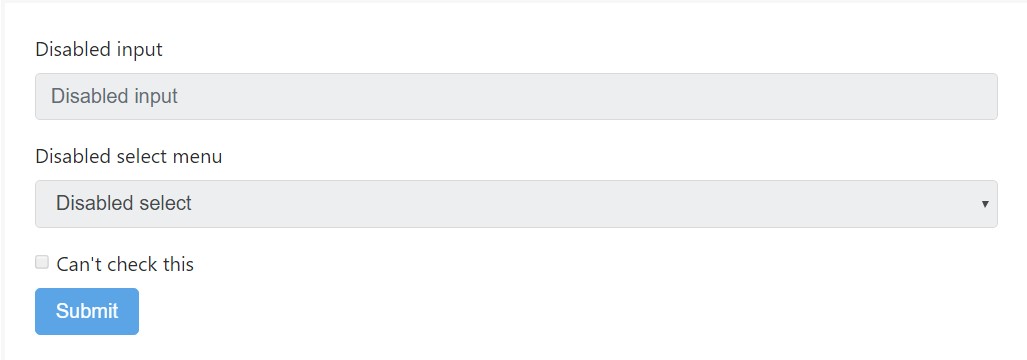
<form>
<fieldset disabled>
<div class="form-group">
<label for="disabledTextInput">Disabled input</label>
<input type="text" id="disabledTextInput" class="form-control" placeholder="Disabled input">
</div>
<div class="form-group">
<label for="disabledSelect">Disabled select menu</label>
<select id="disabledSelect" class="form-control">
<option>Disabled select</option>
</select>
</div>
<div class="checkbox">
<label>
<input type="checkbox"> Can't check this
</label>
</div>
<button type="submit" class="btn btn-primary">Submit</button>
</fieldset>
</form> Warning regarding to url capabilities of <a>
By default, internet browsers will certainly manage all essential form controls (<input>, <select> plus <button> features) within a <fieldset disabled> as disabled, evading each of the computer keyboard plus computer mouse interplays on all of them. However, when your form also features <a ... class="btn btn-*"> features, these are going to only be offered a look of pointer-events: none. As noted in the part in relation to disabled state for buttons (and esspecially in the sub-section for anchor features ), this specific CSS property is not actually yet standardized and isn't fully promoted in Opera 18 and below, as well as in Internet Explorer 11, and will not keep computer keyboard users from having the ability to focus or else activate these particular urls. And so to remain safe, apply custom JavaScript to disable this sort of links.
Cross-browser being compatible
Though Bootstrap will use such formats within all browsers, Internet Explorer 11 and below don't fully support the disabled attribute on a <fieldset>. Work with custom made JavaScript to turn off the fieldset in these kinds of web browsers.
Readonly inputs
Bring in the readonly boolean attribute on an input to prevent modification of the input's value. Read-only inputs look lighter ( exactly like disabled inputs), however retain the regular cursor.

<input class="form-control" type="text" placeholder="Readonly input here…" readonly>Command sizing
Specify heights utilizing classes like .form-control-lg, and also put widths using grid column classes such as .col-lg-*.

<input class="form-control form-control-lg" type="text" placeholder=".form-control-lg">
<input class="form-control" type="text" placeholder="Default input">
<input class="form-control form-control-sm" type="text" placeholder=".form-control-sm">
<select class="form-control form-control-lg">
<option>Large select</option>
</select>
<select class="form-control">
<option>Default select</option>
</select>
<select class="form-control form-control-sm">
<option>Small select</option>
</select>Column sizes
Wrap inputs within a grid columns, or any custom parent component, in order to quickly enforce the wanted widths.

<div class="row">
<div class="col-2">
<input type="text" class="form-control" placeholder=".col-2">
</div>
<div class="col-3">
<input type="text" class="form-control" placeholder=".col-3">
</div>
<div class="col-4">
<input type="text" class="form-control" placeholder=".col-4">
</div>
</div>Help content
The .help-block class is actually lost within the brand new version. In case you require to set special additional words to help your visitors to much better navigate - utilize the .form-text class instead. Bootstrap 4 has fascinating set up within validation formats for the form controls being employed . In this particular version the .has-feedback class has been dropped-- it's no more wanted along with the introduction of the .form-control-danger, .form-control-warning and .form-control-success classes providing a little data icon right inside the input areas.
Connecting support text with form controls
Assistance text ought to be explicitly connected with the form control it really associates with using the aria-describedby attribute. This will guarantee that the assistive technologies-- for example, screen readers-- will declare this help text if the user concentrates or gets in the control.
Block level
Block help text-- for below inputs or for longer lines of the guidance text-- can be conveniently obtained by using .form-text. This specific class involves display: block and also provides some top margin intended for quick spacing from the inputs above.

<label for="inputPassword5">Password</label>
<input type="password" id="inputPassword5" class="form-control" aria-describedby="passwordHelpBlock">
<p id="passwordHelpBlock" class="form-text text-muted">
Your password must be 8-20 characters long, contain letters and numbers, and must not contain spaces, special characters, or emoji.
</p>Inline
Inline content can use any sort of usual inline HTML feature (be it a , <span>, or another).

<form class="form-inline">
<div class="form-group">
<label for="inputPassword4">Password</label>
<input type="password" id="inputPassword4" class="form-control mx-sm-3" aria-describedby="passwordHelpInline">
<small id="passwordHelpInline" class="text-muted">
Must be 8-20 characters long.
</small>
</div>
</form>Validation
Bootstrap incorporates validation formats for danger, warning, and success states on most form controls.
How to use
Here's a run-through of exactly how they perform:
- To make use of, incorporate .has-warning, .has-danger, or .has-success to the parent element. Any .col-form-label, .form-control, or custom-made form feature will be given the validation styles.
- Contextual validation text message, alongside your usual form area guide text message, may possibly be provided along with the usage of .form-control-feedback. This specific text message will adapt to the parent .has-* class. By default it just includes a little bit of margin for spacing and also a customized color for each state.
- Validation icons are url()-s built by using Sass variables which are applied to background-image declarations for each and every state.
- You may apply your unique base64 PNGs or else SVGs with upgrading the Sass variables plus recompiling.
- Icons have the ability to also be disabled totally with setting up the variables to none or else commenting out the source Sass.
Specifying states
Usually speaking, you'll want to use a certain state for particular varieties of feedback:
- Danger is ideal for when there's a blocking or needed field. A user has to submit this particular field correctly to provide the form.
- Warning works successfully for input values which are in improvement, like password strength, or else soft validation prior to a user attempts to submit a form.
- And finally, success is optimal for cases each time you have per-field validation all throughout a form and need to urge a user through the remaining fields.
Examples
Here are some examples of the previously mentioned classes at work. First up is your standard left-aligned fields with labels, guide content, and validation message.

<div class="form-group has-success">
<label class="form-control-label" for="inputSuccess1">Input with success</label>
<input type="text" class="form-control form-control-success" id="inputSuccess1">
<div class="form-control-feedback">Success! You've done it.</div>
<small class="form-text text-muted">Example help text that remains unchanged.</small>
</div>
<div class="form-group has-warning">
<label class="form-control-label" for="inputWarning1">Input with warning</label>
<input type="text" class="form-control form-control-warning" id="inputWarning1">
<div class="form-control-feedback">Shucks, check the formatting of that and try again.</div>
<small class="form-text text-muted">Example help text that remains unchanged.</small>
</div>
<div class="form-group has-danger">
<label class="form-control-label" for="inputDanger1">Input with danger</label>
<input type="text" class="form-control form-control-danger" id="inputDanger1">
<div class="form-control-feedback">Sorry, that username's taken. Try another?</div>
<small class="form-text text-muted">Example help text that remains unchanged.</small>
</div>Those similar states have the ability to additionally be employed with horizontal forms.

<div class="container">
<form>
<div class="form-group row has-success">
<label for="inputHorizontalSuccess" class="col-sm-2 col-form-label">Email</label>
<div class="col-sm-10">
<input type="email" class="form-control form-control-success" id="inputHorizontalSuccess" placeholder="[email protected]">
<div class="form-control-feedback">Success! You've done it.</div>
<small class="form-text text-muted">Example help text that remains unchanged.</small>
</div>
</div>
<div class="form-group row has-warning">
<label for="inputHorizontalWarning" class="col-sm-2 col-form-label">Email</label>
<div class="col-sm-10">
<input type="email" class="form-control form-control-warning" id="inputHorizontalWarning" placeholder="[email protected]">
<div class="form-control-feedback">Shucks, check the formatting of that and try again.</div>
<small class="form-text text-muted">Example help text that remains unchanged.</small>
</div>
</div>
<div class="form-group row has-danger">
<label for="inputHorizontalDnger" class="col-sm-2 col-form-label">Email</label>
<div class="col-sm-10">
<input type="email" class="form-control form-control-danger" id="inputHorizontalDnger" placeholder="[email protected]">
<div class="form-control-feedback">Sorry, that username's taken. Try another?</div>
<small class="form-text text-muted">Example help text that remains unchanged.</small>
</div>
</div>
</form>
</div>Checkboxes and radios happen to be as well maintained.

<div class="form-check has-success">
<label class="form-check-label">
<input type="checkbox" class="form-check-input" id="checkboxSuccess" value="option1">
Checkbox with success
</label>
</div>
<div class="form-check has-warning">
<label class="form-check-label">
<input type="checkbox" class="form-check-input" id="checkboxWarning" value="option1">
Checkbox with warning
</label>
</div>
<div class="form-check has-danger">
<label class="form-check-label">
<input type="checkbox" class="form-check-input" id="checkboxDanger" value="option1">
Checkbox with danger
</label>
</div>Unique forms
To get a lot more customization and cross web browser consistency, make use of Bootstrap absolutely custom form components to remove and replace the internet browser defaults. They're constructed on very top of easily accessible and semantic markup, in this way they are really stable substitutes for any default form control.
Disabled
Customized checkboxes and radios are able to likewise be disabled . Add the disabled boolean attribute to the <input> plus the custom indicator and label information will be systematically designated.

<label class="custom-control custom-checkbox">
<input type="checkbox" class="custom-control-input" disabled>
<span class="custom-control-indicator"></span>
<span class="custom-control-description">Check this custom checkbox</span>
</label>
<label class="custom-control custom-radio">
<input id="radio3" name="radioDisabled" type="radio" class="custom-control-input" disabled>
<span class="custom-control-indicator"></span>
<span class="custom-control-description">Toggle this custom radio</span>
</label>Validation states
Include the various other states to your customized forms along with Bootstrap validation classes.

<div class="form-group has-success">
<label class="custom-control custom-checkbox">
<input type="checkbox" class="custom-control-input">
<span class="custom-control-indicator"></span>
<span class="custom-control-description">Check this custom checkbox</span>
</label>
</div>
<div class="form-group has-warning">
<label class="custom-control custom-checkbox">
<input type="checkbox" class="custom-control-input">
<span class="custom-control-indicator"></span>
<span class="custom-control-description">Check this custom checkbox</span>
</label>
</div>
<div class="form-group has-danger mb-0">
<label class="custom-control custom-checkbox">
<input type="checkbox" class="custom-control-input">
<span class="custom-control-indicator"></span>
<span class="custom-control-description">Check this custom checkbox</span>
</label>
</div>Stacked
Customized checkboxes and radios are inline to start. Add in a parent with class .custom-controls-stacked to make sure each form control is on separate lines.

<div class="custom-controls-stacked">
<label class="custom-control custom-radio">
<input id="radioStacked1" name="radio-stacked" type="radio" class="custom-control-input">
<span class="custom-control-indicator"></span>
<span class="custom-control-description">Toggle this custom radio</span>
</label>
<label class="custom-control custom-radio">
<input id="radioStacked2" name="radio-stacked" type="radio" class="custom-control-input">
<span class="custom-control-indicator"></span>
<span class="custom-control-description">Or toggle this other custom radio</span>
</label>
</div>Select menu
Custom-made <select> menus need to have simply a customized class, .custom-select to activate the custom made designs.

<select class="custom-select">
<option selected>Open this select menu</option>
<option value="1">One</option>
<option value="2">Two</option>
<option value="3">Three</option>
</select>File web browser
The file input is the very most keen of the group and need extra JavaScript supposing that you need to hook them up with useful Choose file ... and selected file name text.
<label class="custom-file">
<input type="file" id="file" class="custom-file-input">
<span class="custom-file-control"></span>
</label>Here’s effective ways to use:
- We wrap the <input> in a <label> with the purpose that the customized control effectively activates the file web browser.
- We cover up the default file <input> via opacity.
- We apply : after in order to develop a customized background and directive (Choose file ...).
- We work with :before to generate and position the Web browser switch.
- We announce a height upon the <input> for proper spacing for surrounding web content .
To puts it simply, it is certainly an absolutely custom made element, entirely developed via CSS.
Translating alternatively customizing the files
The : lang() pseudo-class is used to allow quite easy adaptation of the "Browse" plus "Choose file ..." text in to additional languages. Just simply override or else incorporate gates to the $ custom-file-text SCSS variable with the relevant language mark along with localised strings. The English strings can possibly be individualized the same way. For instance, here's how one could bring in a Spanish adaptation (Spanish's language code is es)
$custom-file-text: (
placeholder: (
en: "Choose file...",
es: "Seleccionar archivo..."
),
button-label: (
en: "Browse",
es: "Navegar"
)
);You'll ought to prepare the language of your document ( or else subtree thereof) accurately needed for the proper message to become revealed. This can be completed using the lang attribute as well as the Content-Language HTTP header, with some other methods.
Final thoughts
Fundamentally these are the new elements to the form elements included inside the most recent fourth version of the Bootstrap framework. The entire feeling is the classes got extra natural and explicit for this reason-- much more simple to work with and together with the customized control components we can easily now get much more predictable appeal of the elements we include within the web pages we create. Now everything that's left for us is figure out the proper data we would certainly demand from our probable site visitors to submit.
How you can utilize the Bootstrap forms:
Related topics:
Bootstrap forms formal documentation
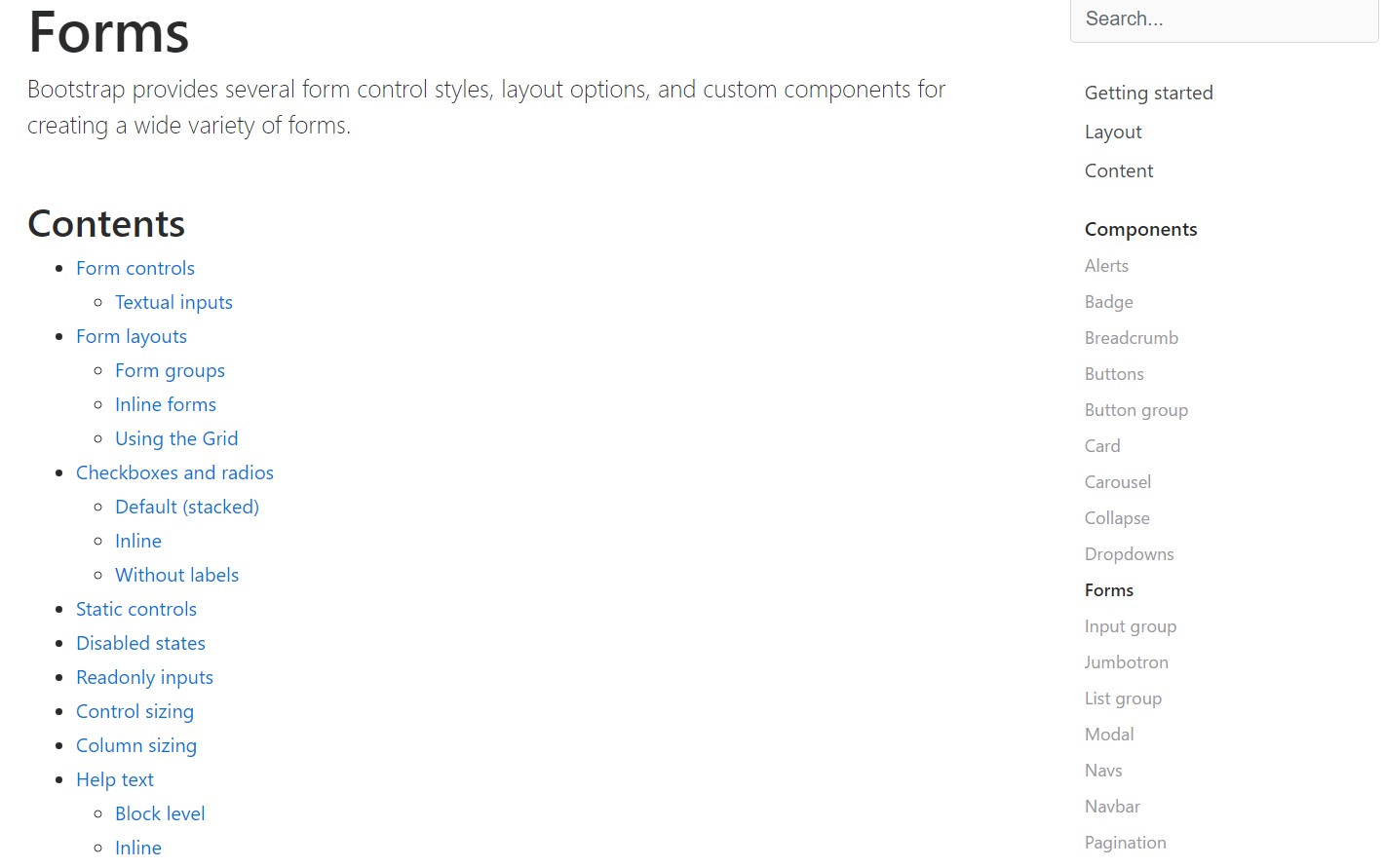
Bootstrap guide

Support for Bootstrap Forms

Why do not we explore AMP project and AMP-form element?
